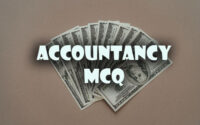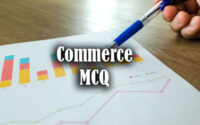Commerce Quiz Questions
1. Which of the following is the correct statement in the context of ‘Accounting Period Concept’?
(A) The life of the business is divided into appropriate time segment to find out the results of operations.
(B) The business will be carried on for a long period of time.
(C) Accounts will be prepared after dissolution of the firm.
(D) Accounting policies are followed from time to time without any change.
2. Which of the following is not the cause of depreciation?
(A) Constant use
(B) Expiry of time
(C) Reduction in market price
(D) Obsolescence
3. A and B are partners in a firm sharing profits in the ratio 3: 2 and advanced a loan of Rs 2,00,000 to the firm in that ratio on 01-04-2021. Accounts are closed on 31st March each year. In the absence of partnership deed, the interest on A’s loan will be
(A) Rs 6,000
(B) Rs 1,600
(C) Rs 2,400
(D) Rs 1,200
4. Section 40 of the Indian Partnership Act states about the dissolution
(A) by notice
(B) on happening of certain contingencies
(C) by agreement
(D) compulsorily
5. At the time of dissolution, trade debtors amounted to Rs 4,50,000 and provision balance was Rs 25,000. The amount of trade debtors that shall be transferred to Realisation Account is
(A) Rs 25,000
(B) Rs 4,25,000
(C) Rs 4,50,000
(D) Rs 435,000
6. Preliminary expense means
(A) petty expense
(B) asset installation expense
(C) expense incurred before incorporation
(D) contingent expense
7. Purchase price of an asset of Rs 17,60,000 was paid by issuing shares of Rs 100 each at a premium of 10%. The number of shares to be issued is
(A) 17600
(B) 16000
(C) 22000
(D) 20000
8. Anand Milk Union Ltd. (AMUL) is a
(A) public limited company
(B) private limited company
(C) government undertaking
(D) cooperative society
9. In the theory of management, who stated the concept of separation of planning and control?
(A) Henry A. Gantt
(B) Frank Gilbreth
(C) Henry Fayol
(D) Frederick W. Taylor
10. Management by Results’ means
(A) attainment of result
(B) organizational result
(C) results from planning
(D) management by objective
11. ‘Great man theory’ is also known as
(A) charismatic leadership theory
(B) trait theory of leadership
(C) P & L model of motivation
(D) need theory
12. Consider the following data :
Cost of goods sold——Rs 2,50,000
Opening inventory—Rs 40,000
Closing inventory——Rs 60,000
The inventory-turnover ratio is
(A) 5 times
(B) 10 times
(C) 4 times
(D) 9 times
13. Primary market and secondary market are the components of
(A) share market only
(B) capital market
(C) money market
(D) call money market only
14. Return on Investment (ROI) is the relationship between
(A) net profit and loan fund
(B) net profit and shareholders’ fund
(C) operating profit and equity share capital
(D) operating profit and loan fund
15. Demat Account is opened for the purpose of investment in
(A) money market
(B) gold market
(C) banks
(D) securities
16. Who are called jobbers in stock exchanges?
(A) Persons working under a broker
(B) Security merchants dealing in shares and debentures as independent operators
(C) Employees of stock exchanges
(D) Job seekers in stock exchanges
17. The function that precedes all other managerial functions is called
(A) Communicating
(B) Motivating
(C) Organizing
(D) Planning
18. Face value of an equity share is Rs 10 and its market price is Rs 50. The number of equity shares is 50000 and profit is Rs 2,00,000 (available to equity shareholders). The earning yield ratio is
(A) 7%
(B) 8%
(C) 4%
(D) 5%
19. ‘Span of control is
(A) number of subordinates who can be managed effectively by a superior
(B) workload assigned to the subordinates
(C) different categories of controlling authorities
(D) control techniques
20. ‘Coordination’ in management means
(A) orderly synchronizing of efforts
(B) unity of individuals
(C) cooperation of unions of workers
(D) cooperation of officers
| Model Question | Old Question |
| Sample Papers | Mock Test |
| Practice Set | Question Bank |
21. Interim audit is conducted
(A) for a part of the year with some interim purpose
(B) after every three months
(C) for a fixed intention during the whole year
(D) periodically
22. The organization of office dunes in such a way as to prevent or dislodge errors and frauds is known as
(A) systematic audit
(B) internal audit
(C) management audit
(D) internal check
23. Which of the following ratios expresses the relationship between shareholders’ fund and total assets?
(A) Proprietary ratio
(B) Solvency ratio
(C) Fixed assets ratio
(D) Debt—equity ratio
24. The main function of EXIM Bank is
(A) granting of direct loans in India and outside for the purpose of exports and imports
(B) granting of loans to industrial houses established abroad
(C) granting of license for export and import
(D) None of the above
25. Who is the custodian of Minute Book of a company?
(A) Company Secretary
(B) Company Auditor
(C) Company Solicitor
(D) Managing Director
26. ‘Benevolent autocrat’ is a/an
(A) leadership style
(B) auditor
(C) communication channel
(D) organization structure
27. ‘Virtual organization’ means
(A) flat structure of organization
(B) tall structure of organization
(C) structureless organization
(D) circular organization
28. Who led the ‘Hawthrone experiments’ in management?
(A) F. W. Taylor
(B) Mary Parker Follett
(C) G. E. Mayo
(D) Peter F. Drucker
29. Control technique of critical path method was developed by
(A) Du Pont Company
(B) General Electric Company
(C) General Motors
(D) TISCO
30. IDBI Bank is a/an
(A) commercial bank
(B) development bank
(C) government bank
(D) industrial bank
31. It is an economic resource which is owned by a business organization and is expected to benefit future operations. It is known as
(A) share capital
(B) revenue
(C) receipt
(D) asset
32. Bill of lading is a document used in
(A) wholesale trade
(B) foreign trade
(C) consignment business
(D) road transportation
33. An asset is recorded in the books of accounts at
(A) cost price
(B) market price
(C) out—of-pocket value
(D) realizable value
34. Matching concept relates to the preparation of
(A) Profit and Loss Account
(B) Balance Sheet
(C) Cash Flow Statement
(D) Fund Flow Statement
35. Contingent liability is shown in the Balance Sheet under
(A) Consistency Principle
(B) Materiality Principle
(C) Disclosure Principle
(D) Going-Concern Principle
36. Revenue is considered as being earned, when
(A) cash is received
(B) production is completed
(C) sale is effected
(D) process is going on
37. Subscription received in advance is
(A) an income
(B) an asset
(C) a liability
(D) an equity
38. Goodwill is
(A) a right asset
(B) a fictitious asset
(C) an intangible asset
(D) a nominal asset
39. Premium brought in by the new partner is shared by the old partners in
(A) sacrificing ratio
(B) gaining ratio
(C) old profit sharing ratio
(D) new profit sharing ratio
40. On dissolution of a firm, if an unrecorded liability is paid, it is shown in
(A) Debit side of Bank Account
(B) Partners’ Capital Account (Credit side)
(C) Liability Account (Credit side)
(D) Debit side of Realization Account
41. Discount allowed on reissue of forfeited shares is debited to
(A) Discount on Issue of Shares Account
(B) Share Forfeiture Account
(C) Reissue of Shares Account
(D) Share Capital Account
42. Short-term solvency is tested by
(A) current ratio
(B) debt-equity ratio
(C) asset-turnover ratio
(D) operating ratio
43. If current ratio is 2.5 : 1 and current liabilities amount to Rs 80,000, current assets will amount to
(A) Rs 1,60,000
(B) Rs 1,80,000
(C) Rs 2,00,000
(D) Rs 2,40,000
44. Showing revenue expenditure as capital expenditure is a/ an
(A) error of omission
(B) error of commission
(C) error of principle
(D) compensating error
45. As per SEBI guidelines, the amount payable on application on each share shall not be less than what percent of the nominal value of share?
(A) 6%
(B) 10%
(C) 5%
(D) 8%
46. ‘Reserve capital’ denotes
(A) reserve of capital profits
(B) reserve of revenue profits
(C) reserve fund for capital expenditure
(D) uncalled portion of capital
47. Accounting principles are generally based on
(A) convenience in recording
(B) discretion of the accountant
(C) practicability
(D) subjectivity
48. The cost which is influenced by a decision is generally termed as
(A) opportunity cost
(B) implied cost
(C) cash cost
(D) relevant cost
49. Plan to buy equipment or material is called
(A) sequencing plan
(B) plan on time
(C) supporting time
(D) operational plan
50. Employer-employee relationship is an example of
(A) controllable premises
(B) tangible premises
(C) internal premises
(D) intangible premises


